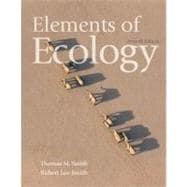
Note: Supplemental materials are not guaranteed with Rental or Used book purchases.
Purchase Benefits
What is included with this book?
Thomas M. Smith, Associate Professor in Environmental Sciences at the University of Virginia, received his Ph.D. in ecology from the University of Tennessee in 1982. The main focus of his research over the past two decades has been to develop an individual based theory of community and ecosystems dynamics. As part of this work he has served on numerous national and international panels that have addressed the potential influence of human activities on the global environment. He has authored over 70 publications based on his research, and he has been recognized as one of the most cited scientists in the field of global change research.
Thomas’s work has taken him to over 70 countries and 6 continents. He has served on the faculty of the University of Witwatersrand (Johannesburg, South Africa), Australian National University (Canberra, Australia), as well as the University of Virginia (Charlottesville, VA, USA). In addition, he has held research scientist positions at both Oak Ridge National Laboratory (Oak Ridge, TN, USA) and the Institute for Applied Systems Analysis (Laxenburg, Austria). He has over 20 years of experience teaching the science of ecology to both science and non-science majors.
Robert L. Smith holds a Ph.D. in Wildlife Biology from Cornell University. He is Professor Emeritus of Ecology at West Virginia University. He has spent over 30 years teaching Ecology and conducting field research throughout the world. His teaching responsibilities have involved mostly undergraduate courses in general ecology and graduate courses in population ecology and wildlife management. His research has included forest-fire related problems in southern West Virginia, vegetational development and succession on abandoned and reclaimed surface mines, the relation between forest vegetational structure and the forest bird community, and forest habitat assessment and habitat evaluation procedures based on vegetational structure.
Smith has served as a consultant to congressional committees, workshops on environmental education and energy and environmental problems, the National Landmarks program of the U.S. Department of Interior, National Research Council Task Forces on wildlife and fisheries issues and ecological classification systems for implementing environmental quality evaluation procedures.
| The Nature of Ecology | |
| The Physical Environment | |
| Climate | |
| The Aquatic Environment | |
| The Terrestrial Environment | |
| The Organism and its Environment | |
| Adaptation and Natural Selection | |
| Plant Adaptations to the Environment | |
| Animal Adaptations to the Environment | |
| Life History Patterns | |
| Populations | |
| Properties of Populations | |
| Population Growth | |
| Intraspecific Population Regulation | |
| Metapopulations | |
| Species Interactions | |
| Interspecific Competition | |
| Predation | |
| Parasitism and Mutualism | |
| Community Ecology | |
| Community Structure | |
| Factors Influencing the Structure of Communities | |
| Community Dynamics | |
| Landscape Ecology | |
| Ecosystem Ecology | |
| Ecosystem Energetics | |
| Decomposition and Nutrient Cycling | |
| Biogeochemical Cycles | |
| Biogeographical Ecology | |
| Terrestrial Ecosystems | |
| Coastal and Wetland Ecosystems | |
| Land-Water Margins | |
| Large-scale Patterns of Biological Diversity | |
| Human Ecology | |
| Population Growth, Resource Use, and Sustainability | |
| Habitat Loss, Biodiversity, and Conservation | |
| Global Climate Change | |
| Table of Contents provided by Publisher. All Rights Reserved. |
The New copy of this book will include any supplemental materials advertised. Please check the title of the book to determine if it should include any access cards, study guides, lab manuals, CDs, etc.
The Used, Rental and eBook copies of this book are not guaranteed to include any supplemental materials. Typically, only the book itself is included. This is true even if the title states it includes any access cards, study guides, lab manuals, CDs, etc.